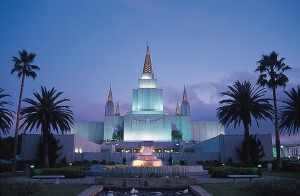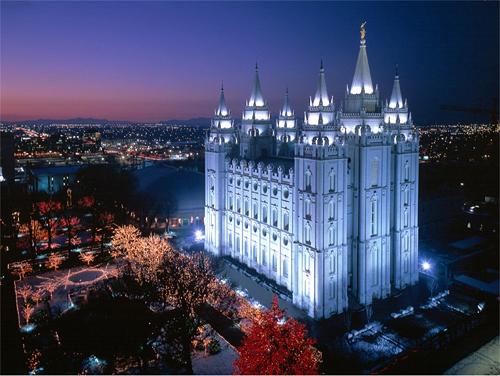There are three major ordinances that are performed in Mormon temples. The first is probably the one over which there is the most confusion. This is baptism for the dead. This doesn’t mean that those for whom the ordinance is being performed automatically become Mormons. It does, however, reflect the love of God for all of his children regardless of their location or whether or not they hear His gospel in this life.
Baptism for the Dead
 In John 3:5, Jesus Christ states that a man must be born of water and of the spirit or he can in nowise inherit the kingdom of God. Untold millions of people have lived on this earth without having received the ordinance of baptism. Some never heard the name of Christ or the doctrines of His gospel. God wants all of mankind to have the opportunity to learn of Christ and lay hold of His saving power. Fortunately, when people pass on from this mortal life, they go to a place called the “spirit world” to await resurrection and judgment. In the spirit world people enjoy the same felicity they had on earth, the ability to exercise the powers of the mind, to make decisions, to learn, to exercise the same personality they manifested on earth. In Section 138 of the Doctrine and Covenants there is recorded a vision seen by early Mormon prophet Joseph F. Smith. He saw the spirit world and saw that the gospel is preached there to all those who did not receive it on earth. President Smith had been reading the New Testament and had been pondering the following verses:
In John 3:5, Jesus Christ states that a man must be born of water and of the spirit or he can in nowise inherit the kingdom of God. Untold millions of people have lived on this earth without having received the ordinance of baptism. Some never heard the name of Christ or the doctrines of His gospel. God wants all of mankind to have the opportunity to learn of Christ and lay hold of His saving power. Fortunately, when people pass on from this mortal life, they go to a place called the “spirit world” to await resurrection and judgment. In the spirit world people enjoy the same felicity they had on earth, the ability to exercise the powers of the mind, to make decisions, to learn, to exercise the same personality they manifested on earth. In Section 138 of the Doctrine and Covenants there is recorded a vision seen by early Mormon prophet Joseph F. Smith. He saw the spirit world and saw that the gospel is preached there to all those who did not receive it on earth. President Smith had been reading the New Testament and had been pondering the following verses:
For Christ also hath once suffered for sins, the just for the unjust, that he might bring us to God, being put to death in the flesh, but quickened by the Spirit: By which also he went and preached unto the spirits in prison; Which sometime were disobedient, when once the long-suffering of God waited in the days of Noah, while the ark was a preparing, wherein few, that is, eight souls were saved by water” (1 Peter 3:18—20).
For for this cause was the gospel preached also to them that are dead, that they might be judged according to men in the flesh, but live according to God in the spirit” (1 Peter 4:6).
These spirits in the spirit world could choose to accept the gospel of Jesus Christ, but they are not able to participate in saving ordinances, because they are disembodied spirits. Thus, those currently living on the earth as mortals with corporeal bodies must perform those ordinances for them by proxy. This work is performed in the house of the Lord, the temple.
 The ordinances are performed in the Mormon temples by proxy for those who have already died. If those working in the temples have the authority to perform these ordinances, then they will be efficacious not only now but in eternity. The authority does exist today in the restored priesthood of the Church of Jesus Christ of Latter-Day Saints, or LDS Church. Through baptisms for the dead, Heavenly Father allows his children to have another chance to choose to follow his commandments. This does not force anyone to accept that baptism. However, it does preserve that individual’s agency, or the right to choose for himself whom he will elect to follow. This ordinance is not new-in a discourse to the people of Corinth Paul himself speaks of this doctrine. Paul is responding to a group of individuals who do not believe in a resurrection, but are following the practice of being baptized for the dead. After his discourse on the necessity and doctrinal certainty of the resurrection, Paul essentially says, if there is no resurrection, what’s the point? 1st Corinthians 15:29 states:
The ordinances are performed in the Mormon temples by proxy for those who have already died. If those working in the temples have the authority to perform these ordinances, then they will be efficacious not only now but in eternity. The authority does exist today in the restored priesthood of the Church of Jesus Christ of Latter-Day Saints, or LDS Church. Through baptisms for the dead, Heavenly Father allows his children to have another chance to choose to follow his commandments. This does not force anyone to accept that baptism. However, it does preserve that individual’s agency, or the right to choose for himself whom he will elect to follow. This ordinance is not new-in a discourse to the people of Corinth Paul himself speaks of this doctrine. Paul is responding to a group of individuals who do not believe in a resurrection, but are following the practice of being baptized for the dead. After his discourse on the necessity and doctrinal certainty of the resurrection, Paul essentially says, if there is no resurrection, what’s the point? 1st Corinthians 15:29 states:
Else what shall they do which are baptized for the dead, if the dead rise not at all? Why then are they baptized for the dead?
This ordinance is not a new invention, but a restoration of an original gospel practice.
The Temple Endowment
The second temple ordinance is called the endowment. This endowment is a gift from Heavenly Father to help his children navigate through life. In the endowment the LDS temple attendee is taught the truths of the Plan of Salvation as outlined in the Bible and other scriptures. These truths teach us the fundamentals about who we are, what we can do in this life, and where we are going. During the review of the Plan of Salvation, we make promises to our Heavenly Father that, if kept, will help us to really live the gospel of Jesus Christ, not just profess a belief in it. These covenants relate to our behavior towards God and our willingness to keep the commandments.
How does this relate to ancient temples? Animal sacrifice was the most central ordinance practiced in ancient temples. The person who brought the sacrificial animal to the temple did so as an offering to enable him to repent. Before the animal was killed, the person’s sins were transferred to the animal, representing Christ’s atoning sacrifice. The sacrifice today is one of time and will; instead of offering animal sacrifice, we offer our own lives in service and worthiness.
At the end of the endowment, each individual enters the “celestial room,” which represents the kingdom of God. No ordinances are performed in the celestial room. Instead, loved ones gather together, and individuals sit and ponder and pray. The celestial room is glorious, peaceful, and beautiful. It is symbolic of what heaven might feel like.
Elder Jeffrey R.Holland, a member of the Quorum of the Twelve Apostles, states, “We all need first aid. We all need an infusion every now and again. We all need hope, and help, and holiness. And the temple does all of that for me” (Holland, Between Heaven and Earth).
Temple Marriage
The third main ordinance performed in the Mormon temples is temple marriage, also called a sealing or eternal marriage. Temple marriages are performed in sealing rooms (see Inside Mormon Temples), and most temples have several. Sealing rooms are not large, but vary in size according to how many guests will witness the sealing. A sealing room is beautiful. There is an altar at the center with a kneeling stair around it. Chairs line the outer walls, and there are mirrors that face each other on opposite walls. When the bride and groom look at themselves in a mirror, the reflection repeats into infinity, symbolic of the eternal covenant. Bride and groom dress in white, and guests dress in Sunday best attire. The officiator is a priesthood holder who holds the priesthood authority (or “keys”) to perform eternal sealings. The marriage vow is not “’till death do us part,” but is an eternal commitment. Mormons believe that members who marry in the temple and lead lives of worthiness can enjoy marriage in the highest kingdom of heaven. Children born to these couples are “born in the covenant,” thereby creating an eternal family.
Next – Entering the Temple

To date, how many individuals have received temple ordinances in the Mormon Church?? How many estimated millions?